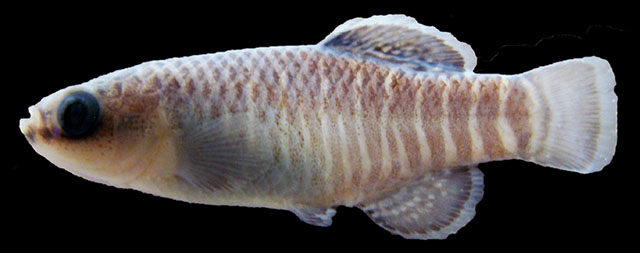| Aphaniidae (Oriental killifishes) |
| 3.93 cm SL (male/unsexed) |
|
benthopelagic; freshwater |
| Asia: Kol River, Hormuzgan Basin in Iran. |
|
Dorsal soft rays (total): 11-15; Anal soft rays: 10-13. This species can be diagnosed from its closely related species Aphanius shirini
by having 9-18 flank bars in males (vs. 7-10), small irregular vertical patches of brown color on the flank of females (vs. prominent dark brown blotches of round or irregular shape), and symmetrically shaped triangular to trapezoid otoliths with a rostrum clearly longer than the antirostrum (vs. quadrangular to trapezoid otoliths with short and equally sized rostrum and antirostrum). It differs from other congeners by the combination of four characters in both sexes: longer anal fin (15.5% SL in males, 12.1% SL in females), larger pelvic fin (8.1-12.5% SL in males, 7.04-10.3% SL in females), greater scale width (4.1-6.0% SL), and otolith characters. Furthermore, males possess greater scale length (3.0-4.8% SL) and small caudal peduncle (0.9-1.5% minimum body depth); and females have short caudal fin length (12.7-19.2% SL) (Ref. 95579). |
| Occurs in low numbers. Threatened mainly by drought and introductions of exotic species, particularly Gambusia holbrooki and Amatitlania nigrofasciata (Ref. 95579). |
|
Not Evaluated (N.E.) Ref. (130435)
|
| harmless |
Source and more info: www.fishbase.org. For personal, classroom, and other internal use only. Not for publication.

